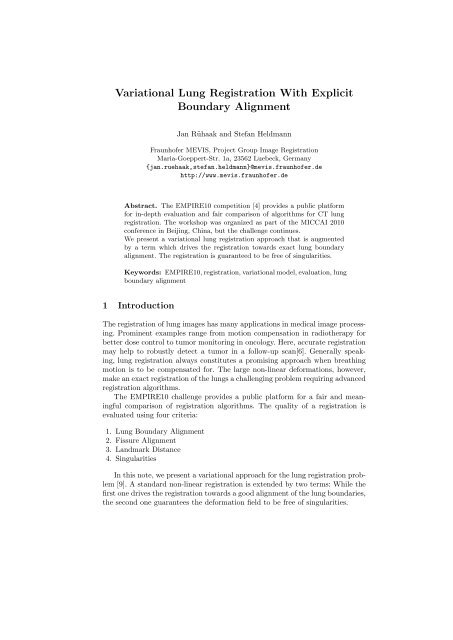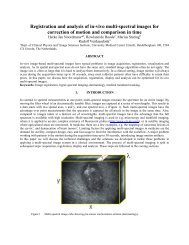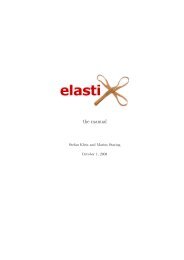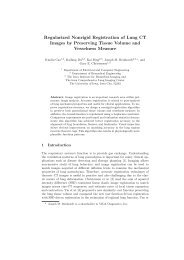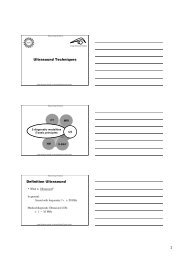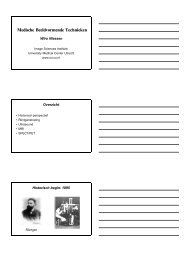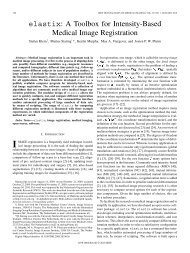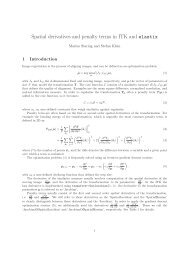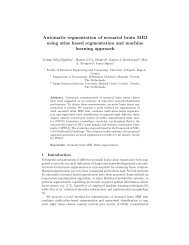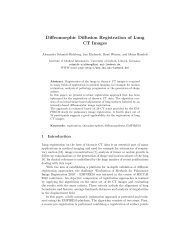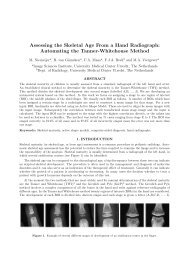Variational Lung Registration With Explicit Boundary Alignment
Variational Lung Registration With Explicit Boundary Alignment
Variational Lung Registration With Explicit Boundary Alignment
Create successful ePaper yourself
Turn your PDF publications into a flip-book with our unique Google optimized e-Paper software.
<strong>Variational</strong> <strong>Lung</strong> <strong>Registration</strong> <strong>With</strong> <strong>Explicit</strong><br />
<strong>Boundary</strong> <strong>Alignment</strong><br />
Jan Rühaak and Stefan Heldmann<br />
Fraunhofer MEVIS, Project Group Image <strong>Registration</strong><br />
Maria-Goeppert-Str. 1a, 23562 Luebeck, Germany<br />
{jan.ruehaak,stefan.heldmann}@mevis.fraunhofer.de<br />
http://www.mevis.fraunhofer.de<br />
Abstract. The EMPIRE10 competition [4] provides a public platform<br />
for in-depth evaluation and fair comparison of algorithms for CT lung<br />
registration. The workshop was organized as part of the MICCAI 2010<br />
conference in Beijing, China, but the challenge continues.<br />
We present a variational lung registration approach that is augmented<br />
by a term which drives the registration towards exact lung boundary<br />
alignment. The registration is guaranteed to be free of singularities.<br />
Keywords: EMPIRE10, registration, variational model, evaluation, lung<br />
boundary alignment<br />
1 Introduction<br />
The registration of lung images has many applications in medical image processing.<br />
Prominent examples range from motion compensation in radiotherapy for<br />
better dose control to tumor monitoring in oncology. Here, accurate registration<br />
may help to robustly detect a tumor in a follow-up scan[6]. Generally speaking,<br />
lung registration always constitutes a promising approach when breathing<br />
motion is to be compensated for. The large non-linear deformations, however,<br />
make an exact registration of the lungs a challenging problem requiring advanced<br />
registration algorithms.<br />
The EMPIRE10 challenge provides a public platform for a fair and meaningful<br />
comparison of registration algorithms. The quality of a registration is<br />
evaluated using four criteria:<br />
1. <strong>Lung</strong> <strong>Boundary</strong> <strong>Alignment</strong><br />
2. Fissure <strong>Alignment</strong><br />
3. Landmark Distance<br />
4. Singularities<br />
In this note, we present a variational approach for the lung registration problem<br />
[9]. A standard non-linear registration is extended by two terms: While the<br />
first one drives the registration towards a good alignment of the lung boundaries,<br />
the second one guarantees the deformation field to be free of singularities.
2 Jan Rühaak and Stefan Heldmann<br />
2 Methods<br />
We first briefly describe the variational registration setting. Let R : R 3 → R<br />
denote the reference (fixed) image and T : R 3 → R the template (i.e. moving)<br />
image with support in domains Ω R ⊆ R 3 and Ω T ⊆ R 3 , respectively. Image<br />
registration tries to find a transformation y : Ω R → R 3 which minimizes a<br />
suitable objective function J often called joint energy functional.<br />
Traditionally, the objective function consists of a distance term D and a<br />
regularization term or regularizer S. The distance term quantifies the similarity<br />
of images whereas the regularizer assesses the smoothness or regularity of the<br />
deformation. Hence, the joint energy functional reads<br />
J (y) = D(R, T (y)) + αS(y) (1)<br />
where α > 0 is the so-called regularization parameter controlling the balance<br />
between data fit (image alignment) and regularity of the deformation.<br />
We use the normalized gradient field (NGF) distance measure<br />
∫ ( ) 2 〈∇T (y(x)), ∇R(x)〉<br />
D(R, T (y)) := 1 −<br />
dx. (2)<br />
Ω R<br />
‖∇T (y(x))‖ ‖∇R(x)‖<br />
NGF focusses on image edges instead of intensities which make it an attractive<br />
choice especially for inhale-exhale data sets with their breathing-related intensity<br />
changes. Smaller edges caused by noise are suppressed by an edge parameter η<br />
(see e.g. [5]). We set η = 100 throughout the registration. From our experience,<br />
however, the registration result is rather insensitive to changes of this parameter,<br />
even by orders of magnitude.<br />
The NGF distance measure is accompanied by the curvature regularizer<br />
S(y) := 1 ∫ 3∑<br />
‖∆(y j − yj kern )‖ 2 dx (3)<br />
2<br />
Ω R<br />
j=1<br />
with the kernel y kern set to the result of an affine-linear preregistration in our<br />
framework. y j denotes the j-th component function of y, yj<br />
kern analogously. The<br />
curvature regularizer penalizes second order derivatives and yields very smooth<br />
solutions.<br />
2.1 Incorporating <strong>Lung</strong> <strong>Boundary</strong> Information<br />
The EMPIRE10 data contains cross-checked lung segmentations for both reference<br />
and template scan which may be used by the contestants. Formally, these<br />
masks define corresponding sets B R ⊆ Ω R , B T ⊆ Ω T and hence binary label<br />
functions<br />
b R : Ω R → {0, 1}, b R (x) = 1 ⇔ x ∈ B R<br />
for R and b T for T , respectively. The registration should respect this area information,<br />
i.e. in the ideal case it holds that<br />
( )<br />
b R (x) = b T y(x) ∀x ∈ Ω R .
<strong>Variational</strong> <strong>Lung</strong> <strong>Registration</strong> <strong>With</strong> <strong>Explicit</strong> <strong>Boundary</strong> <strong>Alignment</strong> 3<br />
We incorporate the segmentation information as an additional term in the objective<br />
function. For this purpose, let<br />
B(y) := 1 2<br />
∫Ω R<br />
(<br />
b T<br />
(<br />
y(x)<br />
)<br />
− bR (x)) 2<br />
dx.<br />
The function B assigns a value to each deformation y which measures the agreement<br />
between the segmentation in the reference scan and the deformed template<br />
image segmentation. This leads to a new objective function<br />
J (y) = D(R, T (y)) + αS(y) + βB(y)<br />
which is to be minimized. Note that the term B coincides with the sum of squared<br />
differences of the segmentation masks as binary images.<br />
2.2 Singularities<br />
The classical variational approach does not vouch for injectivity of the computed<br />
transformation as optimizer of the energy functional. Depending on the data to<br />
be registered and the choice of the regularization parameter α, a minimizer of (1)<br />
may exhibit severe singularities such as foldings or tearings in the corresponding<br />
deformation field and must therefore be considered physically impossible.<br />
Hence, it should be ruled out by a robust image registration method. The fourth<br />
EMPIRE10 criterion is designed to detect such implausible deformations.<br />
From basic calculus, it is known that a continuously differentiable function<br />
y is invertible in a neighborhood of a point p ∈ R d if and only if the Jacobian<br />
det ∇y(p) is non-zero. Moreover, the function preserves orientation of local coordinates<br />
if the Jacobian is positive. The Jacobian also gives information how local<br />
volumes in the neighborhood of p change under transformation. A value of the<br />
Jacobian greater than 1 indicates expansion whereas values | det ∇y(p)| < 1 indicate<br />
shrinkage; the absolute value equals the factor by which the local volume<br />
is expanded or shrinked.<br />
To this end, we introduce an additional energy similar to the approaches<br />
presented in [1, 8] that measures change of volume,<br />
∫<br />
V(y) := ψ(det ∇y(x)) dx<br />
Ω R<br />
with weighting function<br />
ψ(t) :=<br />
(t − 1)2<br />
t<br />
for t > 0 and ψ(t) := ∞ else,<br />
cf. Fig. 1. The weighting function penalizes the deviation of the Jacobian from 1<br />
and therefore measures the local change of volume. Note that ψ symmetrically<br />
penalizes volume expansion and shrinkage since ψ(t) = ψ(1/t). Furthermore, ψ<br />
ensures injectivity of the deformation since ψ(det ∇y) → ∞ as det ∇y → 0.<br />
As a consequence V(y) = ∞ if the Jacobian becomes negative at any point. Our
4 Jan Rühaak and Stefan Heldmann<br />
ψ(t) =<br />
(t − 1)2<br />
t<br />
Fig. 1. Change of volume weighting function ψ<br />
implementation is based on the idea of decomposing each voxel into tetrahedrons<br />
and then directly estimating the Jacobian of the deformation as the ratio of the<br />
volumes of a tetrahedron before and after deformation, cf. [1–3].<br />
Summarizing, we arrive at the objective function<br />
J (y) = D(R, T (y)) + αS(y) + βB(y) + γV(y). (4)<br />
3 Application to <strong>Lung</strong> <strong>Registration</strong><br />
Let R, T denote the reference and template scan with corresponding lung masks<br />
B R and B T . Our lung registration approach consists of two main phases: In<br />
the first step, a rough alignment of the segmentation masks is achieved by a<br />
parametric registration. The resulting deformation is then used as starting value<br />
for the second phase in which the functional (4) is minimized.<br />
3.1 Pre-<strong>Registration</strong><br />
In the pre-registration step, first the centers of gravity of reference and template<br />
mask are computed and aligned. In most cases, this step is redundant, but sometimes<br />
the lung masks do not overlap at all in world coordinates which leaves the<br />
optimization algorithm trapped in the local minimum of zero deformation.<br />
Subsequently, the lung masks are registered using a standard 3D affine-linear<br />
parametric transformation model (see e.g. [5]) with the SSD distance measure.<br />
For this purpose, the masks are downsampled by a factor of five in each dimension<br />
preceded by a Gaussian smoothing. The downsampled masks are again smoothed<br />
in order to spread the boundary information over a larger area.<br />
The optimization is carried out by a Gauss-Newton algorithm. The whole<br />
pre-registration phase takes less than ten seconds on a Mac Pro 2x2.4 GHz<br />
Quad-Core with 32 GB RAM. Our C++ implementation is not heavily optimized<br />
for performance, yet. However, some parts as interpolation and volume<br />
computations have been parallelized on the CPU using OpenMP.
<strong>Variational</strong> <strong>Lung</strong> <strong>Registration</strong> <strong>With</strong> <strong>Explicit</strong> <strong>Boundary</strong> <strong>Alignment</strong> 5<br />
3.2 Non-linear <strong>Registration</strong><br />
Having roughly aligned the mask shape, the main non-linear registration phase<br />
begins. We use a multi-level strategy ranging from course to fine on the CT scans<br />
which are masked using the provided segmentations. The multi-level pyramid is<br />
generated using Gaussian smoothing and subsequent downsampling by a factor<br />
of two. We use four levels for the registration and stop at the second finest level<br />
for computational reasons. As discussed in section 2, we use normalized gradient<br />
fields (2) as distance measure together with the curvature regularizer (3).<br />
Additionally, the deformation grid is also embedded into the multi-level setting.<br />
We do not assign a grid point to every voxel, but employ a grid of 64×64×64<br />
cells on the finest level used in the registration. In between, the deformation is<br />
linearly interpolated which can be regarded as a small additional regularization.<br />
For each coarser level, the deformation grid size is reduced by a factor of two in<br />
each dimension.<br />
We solve the optimization of (4) by a first-discretize-then-optimize approach.<br />
This means, the terms of the objective function are discretized first, yielding a<br />
finite dimensional optimization problem. The minimization is performed by the<br />
limited-memory Broyden-Fletcher-Goldfarb-Shanno (L-BFGS) quasi-Newton optimization<br />
method [7]. The runtime of our algorithm ranges from 1:17 to 5:56<br />
minutes on our system depending on the resolution of the CT scans (see table<br />
1 for details). For all registrations, α = 5, β = 1 and γ = 1 were used as<br />
parameters.<br />
4 Results and Discussion<br />
We have presented an extended variational approach for CT lung registration<br />
that allows for the incorporation of lung segmentation information. It guarantees<br />
invertibility of the computed deformation.<br />
References<br />
1. M. Burger, J. Modersitzki, and L. Ruthotto, “A hyperelastic regularization energy<br />
for image registration,” SIAM Journal on Scientific Computing (submitted), 2011.<br />
2. E. Haber and J. Modersitzki, “Image registration with guaranteed displacement<br />
regularity,” International Journal of Computer Vision, vol. V71, no. 3, pp. 361–372,<br />
2007.<br />
3. E. Haber and J. Modersitzki, “Numerical methods for volume preserving image<br />
registration,” Inverse Problems, vol. 20, no. 5, pp. 1621–1638, 2004.<br />
4. K. Murphy, B. van Ginneken, J. Reinhardt, S. Kabus, K. Ding, X. Deng, and<br />
J.P.W. Pluim, “Evaluations of Methods for Pulmonary Image <strong>Registration</strong>: The<br />
EMPIRE10 Study”, Medical Image Analysis for the Clinic: A Grand Challenge,<br />
Workshop Proceedings MICCAI 2010, http://empire10.isi.uu.nl.<br />
5. J. Modersitzki, “FAIR: Flexible Algorithms for Image <strong>Registration</strong>,” SIAM,<br />
Philadelphia, 2009.
6 Jan Rühaak and Stefan Heldmann<br />
Scan Runtime (min:s)<br />
1 3:22<br />
2 4:38<br />
3 1:58<br />
4 4:17<br />
5 2:01<br />
6 1:32<br />
7 5:38<br />
8 3:19<br />
9 2:35<br />
10 3:04<br />
11 4:20<br />
12 3:12<br />
13 1:27<br />
14 5:56<br />
15 3:30<br />
16 1:51<br />
17 1:30<br />
18 4:25<br />
19 3:31<br />
20 4:42<br />
21 4:45<br />
22 3:54<br />
23 1:17<br />
24 2:39<br />
25 2:54<br />
26 1:56<br />
27 3:04<br />
28 3:06<br />
29 3:31<br />
30 1:21<br />
Table 1. Running time of the non-linear registrations
<strong>Variational</strong> <strong>Lung</strong> <strong>Registration</strong> <strong>With</strong> <strong>Explicit</strong> <strong>Boundary</strong> <strong>Alignment</strong> 7<br />
6. J.H. Moltz, M. Schwier, and H.-O. Peitgen, “A General Framework for Automatic<br />
Detection of Matching Lesions in Follow-Up CT”, Proceedings of the 2009 IEEE<br />
International Symposium on Biomedical Imaging: From Nano to Macro, Boston,<br />
MA, USA, June 28 - July 1, 2009, pp. 843-846.<br />
7. J. Nocedal and S.J. Wright, “Numerical optimization”, Springer, 2006.<br />
8. T. Rohlfing, C. R. Maurer, D. A. Bluemke, and M. A. Jacobs, “Volume-preserving<br />
nonrigid registration of mr breast images using free-form deformation with an incompressibility<br />
constraint,” IEEE Transactions on Medical Imaging, vol. 22, pp. 730–<br />
741, 2003.<br />
9. J. Rühaak, S. Heldmann, B. Fischer: “Improving <strong>Lung</strong> <strong>Registration</strong> by Incorporating<br />
Anatomical Knowledge: A <strong>Variational</strong> Approach”, Fourth International Workshop<br />
on Pulmonary Image Analysis, MICCAI 2011, Toronto, Canada.


